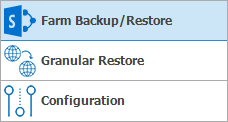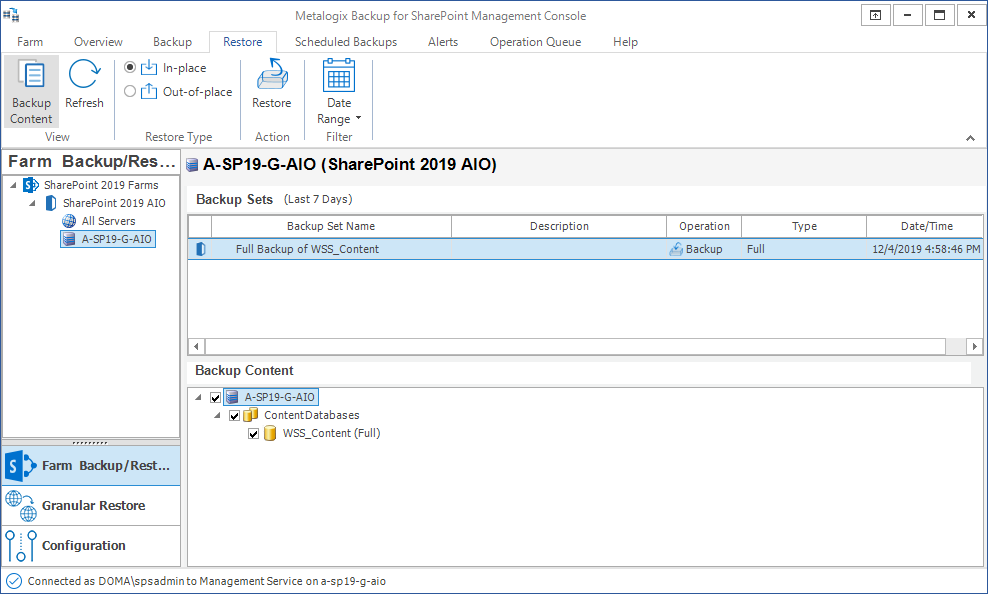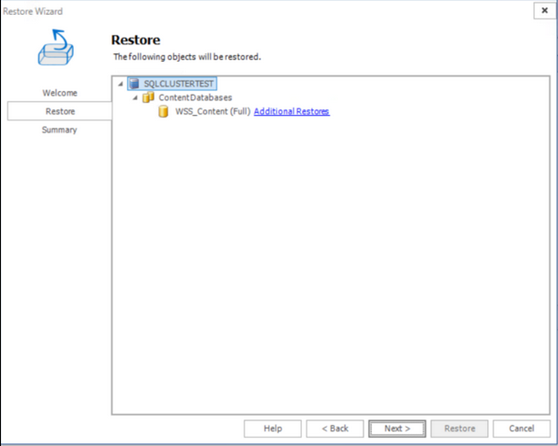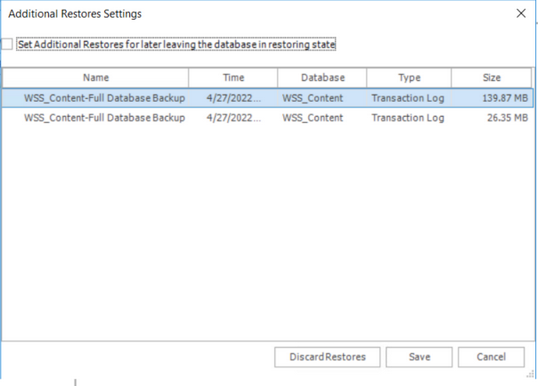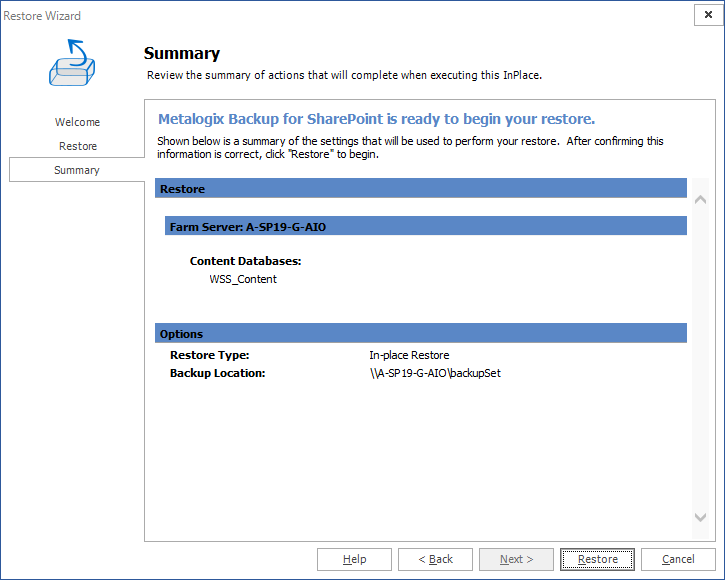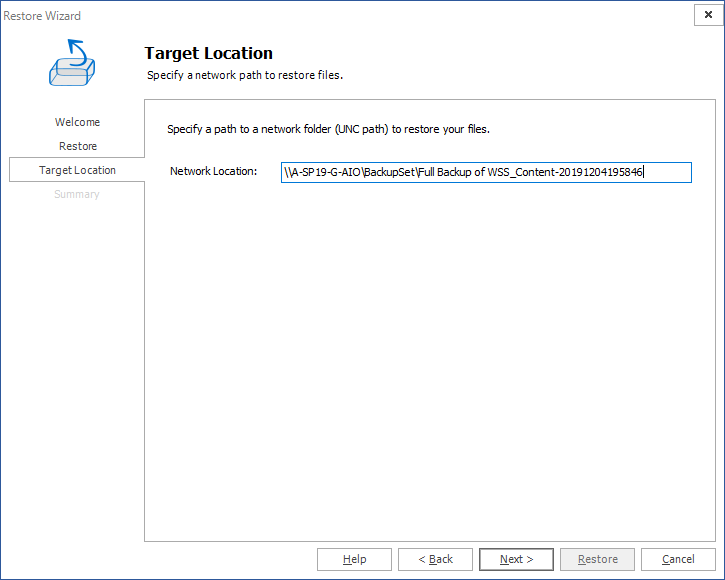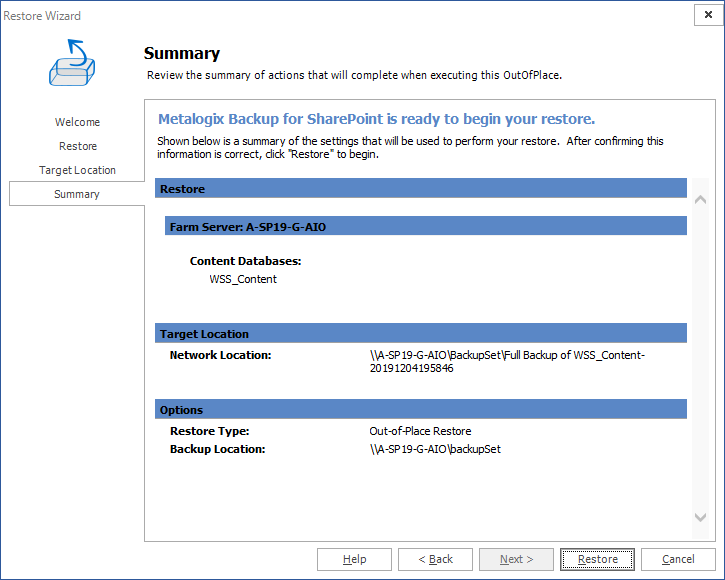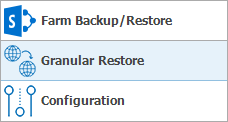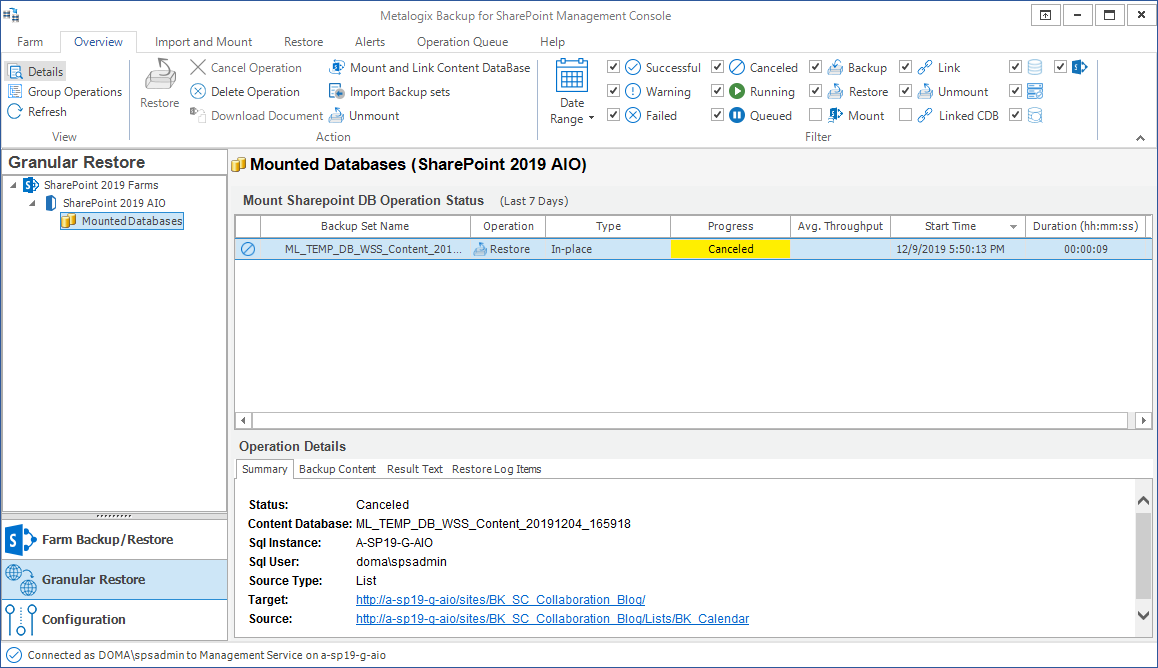Restoring from farm backups
The Restore tab of the Farm Backup/Restore view in the Management Console lets you restore backed-up SharePoint 2010, 2013, 2016 and 2019 farm backups. Restorations can be done as in-place restores or out-of-place restores. An in-place restore returns the backed-up components to their original locations, replacing any existing files. Some components cannot be restored in-place, including the following:
·.NET framework configuration
·Certificate store
·Global assembly cache
·IIS configuration
·IIS Metabase
·SharePoint registry
·SharePoint root
·SharePoint Web application roots
In addition, you can only restore the SharePoint configuration databases as part of a complete restore of the farm.
For these components, it is not possible to guarantee that only Metalogix Backup for SharePoint is making changes to the files while the restore is in progress. If both Metalogix Backup for SharePoint and another process tried to write to the file at the same time, the result could be catastrophic for your farm or for the server. The farm or the server could fail to function in this event. For this reason, Metalogix Backup for SharePoint prevents an in-place restore of the components.
You must restore these files out of place, then manually recreate the SharePoint farm configuration based on the files.
If you perform an in-place restore while your SharePoint farm is active and available to users, the users may encounter errors when they try to access content that Metalogix Backup for SharePoint is actively restoring. The content should be available after a short interval. If a user is viewing content or has the content checked out and Metalogix Backup for SharePoint restores the content, the version the user has may no longer be valid. Metalogix Backup for SharePoint restores the version of the content that was current during the backup, including the checkout state of the content.
An out-of-place restore places the files in a UNC location that you specify. You can manually return the content to your SharePoint farm.
How do I select the backed-up components to restore?
You use the Restore tab in the Farm Backup/Restore view to select the components to restore.
To select the components to restore
1.From the Management Console workspace selector click Farm Backup/Restore.
2.In the Farm Backup/Restore pane, click any server name or All Servers for any farm.
3.Click the Restore tab.
4.In the Backup Content pane, select the check boxes for the components to restore. If the Backup Content pane is not visible, click Backup Content in the ribbon.
You can right-click any node in the Backup Content pane and choose from the following actions: Select All, Unselect All, Expand Tree From Here or Refresh.
How do I perform an in-place restore?
You use the Restore tab in the Farm Backup/Restore view to perform an in-place restore.
To perform an in-place restore
1.In the Management Console, in the left pane, click Farm Backup/Restore.
2.In the Farm Backup/Restore pane, click any server name or All Servers for any farm.
3.Click the Restore tab.
4.In the Backup Content pane, select the check boxes for the items to restore. If the Backup Content pane is not visible click Backup Content in the ribbon.
5.In the ribbon, select In-place and then click Restore. The In-Place Restore Wizard starts.
6.Click Next in the Welcome step of the In-Place Restore Wizard. The Restore step appears.
Additional Restores allows the restore to use Transactional Log Backups taken in SQL Management Studio for restoring the database from a full backup. This option will only be visible for In Place Restores. Click the Additional Restores link to open the interface.
·Check the box to set the Database to a Restoring state, allowing the user to restore from Transaction logs in SQL Management Studio, under Tasks.
· You can also select the name of the backup and click Save to restore from the Transaction Log.
·Discard Restores removes the transaction log backup from the Additional Resources window.
Transaction Log Information, including shrinking the file after restore, can be found here: The Transaction Log (SQL Server) - SQL Server | Microsoft Docs
7.Review the content to restore and then click Next. The Summary step appears.
8.Review the restore operation summary and then click Restore.
How do I perform an out-of-place restore?
You use the Restore tab in the Farm Backup/Restore view to perform an out-of-place restore.
To perform an out-of-place restore
1.From the Management Console workspace selector click Farm Backup/Restore.
2.In the Farm Backup/Restore pane, click any server name or All Servers for any farm.
3.Click the Restore tab.
4.In the Backup Content field, select the check boxes for the items to restore. If the Backup Content pane is not visible click Backup Content in the ribbon.
5.In the ribbon, select Out-of-place and then click Restore. The Out-Of-Place Restore Wizard starts.
6.Click Next in the Welcome step of the Out-Of-Place Restore Wizard. The Restore step appears.
7.Review the content to restore and then click Next. The Target Location step appears.
In the Network Location field, enter a UNC location where Metalogix Backup for SharePoint should place the restored content.
8.Click Next. The Summary step appears.
9.Review the restore operation and click Restore.
Restoring granular objects
Metalogix Backup for SharePoint can back up SharePoint objects from SharePoint 2010, 2013, 2016 or 2019 farms. Backups can be run on demand, or on a schedule that works best for the farm.
The initial backup should always be a full backup. This enables subsequent backups to be either full backups like the initial backup, or smaller, differential backups which will only contain objects that have changed since the last full backup. The backups can then be used to reinstate SharePoint farms as needed.
Although Metalogix Backup for SharePoint no longer creates granular backups, granular backups created using previous versions of SharePoint backup can be used to restore SharePoint objects. It is important to note that granular objects can only be restored to the same version of SharePoint from which the granular backup was initially created.
Viewing the granular restore status and results
The Overview tab displays the status of each backup, mount, link, or restore operation. Metalogix Backup for SharePoint combines the specified Filter options to determine which operations to display in the Backup/Import and Mount/Restore Operation Status list. The Operation Details pane provides additional information about the operation selected in the Backup/Import and Mount/Restore Operation Status list.
How do I open the Overview tab?
The Overview tab is part of the Farm Backup/Restore and Granular Restore views in the Management Console. The Overview page applies to the selected farm.
To open the Overview tab
1.From the Management Console workspace selector select Granular Restore.
2.From the Granular Restore pane, select All Servers or a mounted database.
3.Click the Overview tab.
What actions can I perform in the Overview tab?
You perform the following actions in the Overview tab:
Details - You can view or hide the Operation Details pane by clicking Details in the top panel.. The details pane includes additional information about the selected operation.
Group Operations - You can choose to group operations in the status field by selecting Group Operations. When you group operations, differential backups are attached to the related full backups.
Refresh - You can manually refresh the operation status field by clicking Refresh.
Restore - When you select a backup operation in the status area, you can click Restore to restore the backed-up data.
Cancel Operation - When you select a running operation, you can click Cancel Operation to stop the operation.
Delete Operation - When you select an operation, you can click Delete Operation to delete the operation from the status list.
Download Document - You an select a document from the Backup Content tab in the Operation Details section, and view the document when you click Download Document.
Mount and Link Content database - You can start the Content Database Mount and Link Wizard to mount backup files or link content databases.
Import Backup sets - You can download backup sets from predefined backup set locations.
Filter data in the status field - You can select or clear the check boxes in the Filter area to control the items that appear in the status field. You can also filter the result in the status field by date range.
What actions can I perform in the Operation Queue tab?
You perform the following actions in the Operation Queue tab:
Details - You can view or hide the Operation details pane. The details pane includes additional information about the selected operation. In order to view or hide the Operation details pane, click Details in the top panel. For more information, see What information does the details pane include?
Refresh - You can manually refresh the operation status field.
Cancel Operation - When you select a queued operation, you can click Cancel Operation to stop the operation.
How can I open the Operation Details pane?
The Details pane normally appears at the bottom of the Overview tab. If the Details pane does not appear at the bottom of the window, you can make it visible using the following steps.
To display the Operation Details pane
1.From the Management Console workspace selector click either Granular Restore or Farm Backup/Restore.
2.In the top left hand panel click either All Servers or Mounted Databases.
3.In the right pane, click the Overview tab.
4.If the Operation Details pane does not appear, click Details.
What information appears in the Operation Details pane?
The Details pane displays the following information:
Summary - A brief summary of the selected operation. The summary includes the operation type, the operation status, the backup set name and location, the user credentials used, the Backup Service that performed the operation, and the directory where the backup set was saved after a successful operation
Server Operations - The Server operations, including the servers name, the progress of the operations, its size and start time.
Backup content - The content that was backed-up or restored. The content appears in a collapsed tree view
Result Text - The results of the backup or restore operation. This includes specific details regarding successes and failures.
Description - The description of the selected item that you entered when you created the item.
Canceling running granular backup or restore operations
You can cancel any currently-running restore operation in Metalogix Backup for SharePoint. If you cancel a running operation that started on a schedule, Metalogix Backup for SharePoint does not cancel the schedule.
How do I cancel a running restore?
Use the Management Console to cancel a running operation.
To cancel a running backup or restore operation:
1.From the Management Console workspace selector click Granular Restore for a granular restore operation.
2.In the granular Restore pane, click the node with the running operation.
3.Click the Operation Queue tab in the top panel.
4.Select the restore operation you would like to cancel and click Cancel Operation.
5.In the confirmation dialog that opens, click OK.
6.Click the Overview tab. The canceled operation is listed in the Mount Sharepint DB Operation Status list if the Canceled filter setting in the ribbon is checked.
7.The details of the canceled operation are displayed in the Operation Details pane. If no details are visible, click Refresh.

